Kevin Durant Shooting Drills and Workout With Videos
The Kevin Durant shooting workout is a great workout because it incorporates shooting, ball handling, footwork, and finishing drills that you will use in game-like situations. These are the type of drills that the pros use to get better.
In this article, you will learn a super-efficient way to get open that Kevin Durant does all of the time. Below, you will also see a video that Kevin demonstrates the move and a second video of the Kevin Durant shooting workout that we've been taking some of our players through.
The Kevin Durant Post CutKevin Durant frequently uses this super-efficient and easy way to get open, but for some reason, very few people use this cut. It also takes a lot less energy.
It's called the post cut. You take the defender down to the mid-post or high post area, post up on the defender, as soon as you feel like you have the defender on your back, you put your hand up and cut out to the perimeter to create space. Sometimes, you don't even have to cut. You can just step out and use a reverse pivot to create space.
Below, we have a sample video of the move used by Kevin Durant. You only have to watch 0:52 to 1:02 in the video.
In the video above, Durant just steps out, but you can also cut out and use the same footwork as you can see in the workout video below.
It's very important that you step out and get ready to shoot as quickly as possible. If you are open and can consistently make the shot, you shoot the ball. If the defense takes away your shot, now you should take advantage of the defense closing out and blow by the defense. You will see a series of shooting progressions below.
To get FREE 5 Shooting Drills To Make More 3's, click the banner below
Kevin Durant Workout Details:
Take a set number of shots from each side of the court for each progression.Examples of Workouts
Beginner - 5 shots attempted on each side of the court. Shoot 5 free throws.
Intermediate - 5 shots made on each side of the court. Make 5 free throws.
Advanced - 10 shots made on each side of the court. Make 10 Free throws.
Random - Shoot a different shot each time. Shoot 2 free throws.
Once you have developed consistency with your footwork and your shooting, this can be a great way to simulate games where you rarely get the same shot twice in a row. It is also a great way to practice game-like free throw shooting with only 2 free throws at a time.
For example, you might choose a series of 3 to 5 shots. If you take the drill above, here is a sample that you can do.
1. Post Cut - Reverse Pivot - Shot.
2. Post Cut - Reverse Pivot - Sweep - Lay Up.
3. Post Cut - Reverse Pivot - Sweep - Shot.
4. Two Free Throws.
Track and chart your shots to gauge progress.
The Key to This Workout Is in the Details!
You might look at this workout and think, "Duh. There isn't anything special there." Well, there isn't anything special in WHAT you do, but what separates the great players from the good players and the good players from the okay players is HOW you do things. Pro players incorporate these same drills and they probably use a lot of the same drills that you use, but what makes them great is HOW they execute the drills.
You will see the details mentioned in the progressions below.
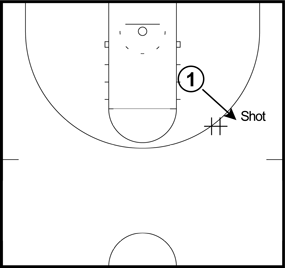
Progression 1 - Reverse Pivot - Shot
You need to get the defender on your back. Otherwise, the initial cut won't be open.
You need to repeatedly practice the step-out and reverse pivot at full speed so you can get the shot off in a split second while making a high-percentage of your shots. If you don't, the defense can easily take it away because the defense has more time to recover to contest your shot and get set to defend the dribble drive.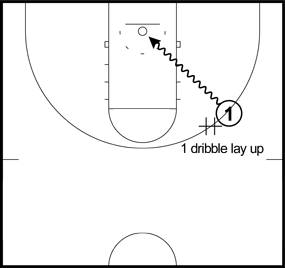
Progression 2 - Reverse Pivot - Sweep - 1 Dribble Lay Up
Sweep (rip) aggressively below your knees. Get to the rim in one dribble
As long as you become effective with your step-out and reverse pivot in progression 1, this will force the defense to close out at full speed. If you have the defender closing out at full speed, this puts you at a huge advantage to drive by the defender because they have to sprint at full speed to stop your shot, then they have to stop, and then they go in the opposite direction to stop your dribble drive. You have the advantage! This is how SLOW players like Larry Bird were so effective.
Now, it's also important that you get to the basket in one dribble. This will get you to the basket quicker and put more pressure on the defense. If you don't, it allows recovery time for the defense to take away an easy basket that you could have had.
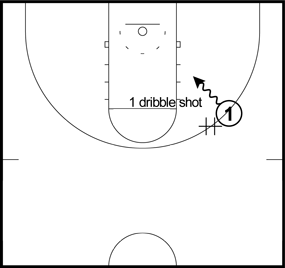
Progression 3 - Reverse Pivot - Sweep - 1 Dribble - Shot
Make sure to cover ground on the dribble.
Progression 3 is set up by being great at progression 1 and 2. If you don't have the mentality to aggressively attack the basket (progression 2) after somebody takes away your initial shot (progression 1), the jump shot will not be open.
In order to be effective, you need to create separation with the dribble. Otherwise, the dribble will not get you anywhere and the same defender who you initially had an advantage against can disrupt your pull up jump shot. You see this often when the defender blocks the shooter from behind.
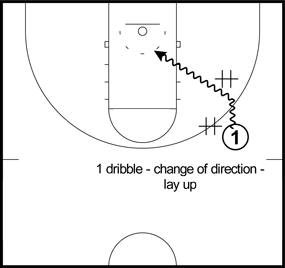
Progression 4 - Reverse Pivot - Sweep - 1 Dribble Change - Lay Up
Dribble hard at the chair, snap the ball below the knees and close to the body on the change of direction. Make it game-like.
Progression 4 is another counter to Progression 1 and 2. If the help defense slides over (second chair), you can now change directions with the dribble and attack the rim. If you are not aggressive with your dribble, the defender can attack and control what you do. By being aggressive with the 1st, 2nd, and 3rd dribble (if needed to score the lay up), this puts the defense on their heels and gives the advantage back to you.
In the video above, we used 3 dribbles because we were working on becoming effective with a low crossover with this player. You can also perform the drill with 2 dribbles by using the push crossover which players like Dwyane Wade and Manu Ginobli are highly effective at.
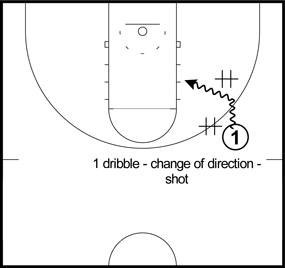
Progression 5 - Reverse Pivot - Sweep - 1 Dribble Change - Shot
Cover ground on the change of direction to create space for the shot.
Progression 5 is a counter to Progression 1, 2, and 4. Now the defense is sending everybody at you because you're destroying your man and even picking apart the first line of help defense.
After you change directions at the first help defender (second chair), the defense has sent everybody to the lane, so now you pull up for a jump shot. Just like on progression 3, you need to create separation with your dribble. So make sure to snap that change of direction dribble to cover lots of ground to open up space for your jumper.
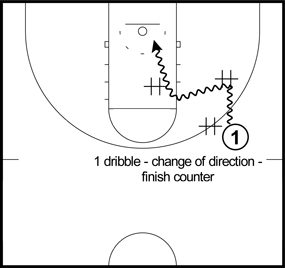
Progression 6 - Reverse Pivot - Sweep - 1 Dribble Change - Finish Counter
Dribble hard at the third chair, you have to make the defender commit to open up the finish counter whether it's a drop step (spin), step through (up and under), a Rondo, side step (Euro Step), or any other creative, effective finishing move.
This is a counter to progression 1, 2, and 4. If the help defense slides over to stop you after your change of direction dribble, you can use a finishing counter to attack the defense and get to the rim. However, this isn't effective if you don't perfect the details. If you dribble at the 2nd help defender (3rd chair) hesitantly, they can easily cover your finishing counter move and disrupt your shot. It's vital that you dribble at the 3rd chair as aggressively as you can, this will get you in the habit of getting that help defender on their heels which will leave your finishing counter move wide open.
Now, you certainly don't need to perfect all of the progressions to be a good player. You should work on perfecting the 1st, 2nd, and 3rd progressions. Besides being better than 99% of the players out there after you perfect those 3 progressions, you can start to add the additional progressions.
Wanted to give a special thanks to Don Kelbick for being a huge influence on our training methods and making us better coaches which leads to better players.
Also wanted to give a special thanks to Kyle Wolf who is the shooter in the video below. Kyle is a 6'6 forward at Rockhurst High School (Class of 2013) in Kansas City, Missouri.
(Updated 12/4/2014 - Kyle went on to win the Missouri Gatorade Player of the Year in 2013 and led his team to a Class 5 state championship. In 2014 during his freshmen year, he started in 18 games and was a key contributor for Central Missouri University as they went on to win the NCAA Division 2 National Championship. Hard work with an organized plan pays off.)
Sign up for our FREE newsletter to receive more tips, drills, workouts, plays, etc. to improve your game!
Related Articles and Products
- Attack & Counter Workouts
- Skill Development Camps
- Ray Allen Shooting Drill
- The Myth of the Triple Threat
To get FREE 5 Shooting Drills To Make More 3's, click the banner below
What do you think? Let us know by leaving your comments, suggestions, and questions...
|
||||||||||||||||||||||||

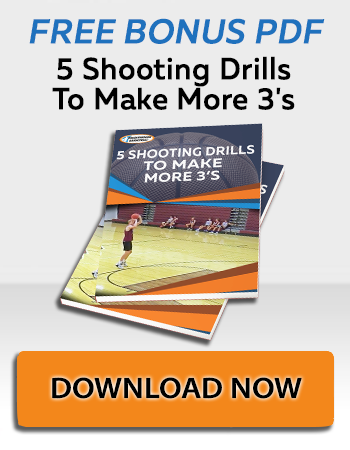


 Facebook (145k Followers)
Facebook (145k Followers) YouTube (152k Subscribers)
YouTube (152k Subscribers) Twitter (33k Followers)
Twitter (33k Followers) Q&A Forum
Q&A Forum Podcasts
Podcasts